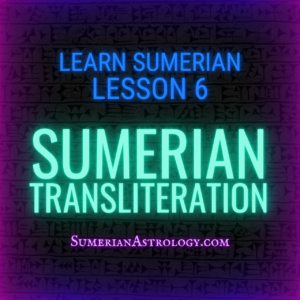Lesson 6
Sumerian Transliteration
In this lesson, you’ll learn more about Sumerian Transliteration techniques, after which, you can take a short quiz to test your knowledge of cuneiform signs and transliteration techniques!
Need a Refresher on Sumerian Translation?
Helpful Terms
Here is a list of helpful terms you’ll encounter in this lesson. You can see the full Glossary of Terms here.
- case marker: a particle suffixed to a noun to indicate the role it plays in a sentence; also called a postposition.
- cuneiform: a wedge-shaped logo-syllabic script developed by the Sumerians and used by the Akkadians, Assyrians, and Babylonians, and currently recognized as the oldest known writing system.
- diacritic: a mark or symbol added to a letter to change its pronunciation or meaning.
- polyvalency: having more than one value, such as a sound or meaning, as in the cuneiform 𒂠, which can be read as éš, and šè, among others.
- postposition: unlike a preposition which is prefixed to a noun, a postposition is a particle suffixed to a noun to indicate the role it plays in a sentence.
- transliteration: writing the sounds of one language using the characters or alphabet of another.
Vocabulary to Memorize
I highly recommend memorizing these Sumerian words, as you’ll encounter them often in the upcoming lessons!
- ba 𒁀 n., allotment, portion, wages. v., to give; pay; divide; distribute; allot.
- dù 𒆕 v., to beget; bear (a child); be born; build, create, fashion, make; transform, change.
- ĝu10 𒈬 pron., my, mine.
- lugal 𒈗 n., king; owner, master, lord.
- tur 𒌉 n., child; young; second (rank). v., to be/make small; reduce.
Vocabulary--Full List
Here are the vocabulary terms for this lesson. Be sure to look them over as they’re updated with additional meanings each lesson. You can see the full Sumerian Lexicon here.
- an 𒀭 n., heaven; high.
- ba 𒁀 n., allotment, portion, wages. v., to give; pay; divide; distribute; allot.
- dù 𒆕 v., to beget; bear (a child); be born; build, create, fashion, make; transform, change.
- e 𒂊 v., to speak, say; do; water. part., [performed] by (the agent); in, at, beside.
- ĝe26 𒂷 pron., I, me, myself.
- ĝu10 𒈬 pron., my, mine.
- ka 𒅗 n., mouth; opening; beginning, origin; body part.
- ki 𒆠 n., earth, area. prep., where.
- lugal 𒈗 n., king; owner, master, lord.
- me 𒈨 n., function, office, responsibility; divine power/decree. cop., I am (OS); you are (NS). v., to say, tell. adv., where?
- šeš 𒋀 n., brother; colleague; assistant.
- tur 𒌉 n., child; young; second (rank). v., to be/make small; reduce.

As you learned in the previous lesson, cuneiform signs can be read in multiple ways, a phenomenon known as polyvalency (lit. multiple values).
The cuneiform script uses 600 – 1000 word signs.
While that sounds like a lot, many of these are just combinations of other signs, such as when ka 𒅗 and me 𒈨 combine to become eme 𒅴.
While this makes learning cuneiform easier, it also results in some signs being used a lot more than others.
For example, when used to mean the pronoun I/me/myself, the cuneiform sign 𒂷 is transliterated as ĝe26. The ‘26’ after ĝe indicates that there are 25 other possible readings that come before it!
Fortunately, you won’t need memorize most cuneiform signs unless you’re translating clay tablets in some museum vault somewhere.
Diacritics
The most common readings of a sign are usually the first, second, and third.
To make things a little easier on the eyes, modern Sumerologists use diacritics to indicate how the cuneiform sign should be read.
More specifically, they:
- leave the first reading unmarked: /a/
- put a right-facing mark above the second reading: /á/
- put a left-facing mark over the third reading: /à/
- mark the fourth reading and beyond with the appropriate number in subscript: /a4/
In other words:
- /a1/ = /a/
- /a2/ = /á/
- /a3/ = /à/
- /a4/ = /a4/
Be aware that this technique is used simply to make transliteration easier, and has nothing to do with pronunciation.
Encountering Sumerian and Akkadian
One of the reasons Sumerian remained in use for so long was due to its adoption by the Akkadians. In fact, we owe our translations of the cuneiform script to Akkadian scribes who meticulously translated their own texts into Sumerian.
For this reason, you’ll almost certainly encounter Akkadian during your Sumerian language journey.
When you do, remember that Akkadian words are normally lowercase and italicized, while Sumerian words are usually lowercase and sometimes boldface.
NOTE: I always put my Sumerian in boldface to help it stand out.
However, in later Mesopotamian texts, you’ll also see Sumerian words written in ALL CAPS:
- in documents where the Sumerian word wasn’t translated
- LUGAL kib-ra-a-ti
- LUGAL 𒈗 is Sumerian
- kib-ra-a-ti is Akkadian
- LUGAL kib-ra-a-ti
- when a Sumerian word-sign has an unknown value
- KA-ĝu10 𒅗𒈬 my body part
- -ĝu10 𒈬 my
- KA 𒅗 (we know it’s a body part, but we’re not sure which one)
- KA-ĝu10 𒅗𒈬 my body part
Use of Periods
In literature, compound Sumerian words which are meant to be read together are often written in ALL CAPS and connected by a period, as in the name of the Sumerian moon-god Nanna dnanna𒀭𒋀𒆠, which you may see written out with as the compound sign dŠEŠ.KI.
NOTE: A ‘d’ in superscript indicates that the following word is the name of a deity. We’ll discuss this diacritic more in a later lesson.
Use of Hyphens
In Sumerian transliteration, you’ll often see hyphens used to connect:
- proper nouns and nominal compounds, as in
- an-ki 𒀭𒆠 earth and heaven
- nouns and adjectives*, as in
- šeš-tur 𒋀𒌉 young(er) brother
- nouns and case markers/postpositins, as in
- lugal-e 𒈗𒂊 by the king
- elements within the verbal chain, as in
- ba-an-dù 𒁀𒀭𒆕 he/she built it
NOTE: Adding a hyphen between a noun and adjective has gone out of fashion in modern literature, but I still like to add hyphens between simple nouns and adjectives.
Additional Symbols You May Encounter
While learning Sumerian, you may encounter some of the following symbols:
- √—indicates the root verb
- C—indicates a consonant
- V—indicates a vowel
- x—indicates no generally accepted value exists
- Ø—indicates the zero ending of the absolutive case
- { }—demonstrates a linguistic construction
- [ ]—indicates missing or damaged text
- < >—indicates text believed to have been omitted by scribes
- << >>—indicates text erroneously omitted in modern times
Your Sumerian Language Journey Continues!
You’re rapidly becoming a master of Sumerian Transliteration techniques! In the next lesson, you’ll learn about the Sumerian grammatical cases, so be sure to subscribe!










